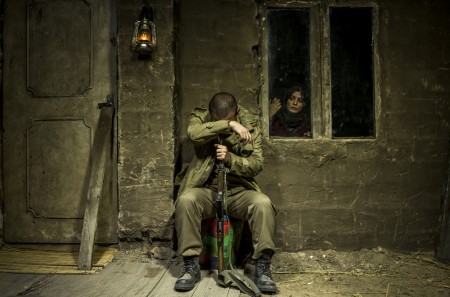Part of Edinburgh Iranian Festival
Nobody Dies Here begins with young conscript Ashkan (Houman Seyyedi) adjusting to being posted to a remote military outpost in a rural area on the Iranian border. However, when he meets a young local woman, Rojin (Bahar Katouzi), who has foreknowledge of the identities of Ashkan and his superiors and whose behaviour towards him is inconsistent, the soldier’s old demons begin to haunt him as he begins to question his rapidly unravelling sanity.
Kondori effectively conveys Ashkan’s initial isolation with atmospheric, long establishing shots of the remote mountain ranges and deserted landscapes surrounding the outpost. He similarly portrays Ashkan’s later mental decline through a range of visual and aural effects that are sufficiently disruptive in representing the character’s fractured mental state without coming across as unnecessary stylisation over narrative substance. A fine example of one of these techniques comes during a sequence where earth-toned shots of a sleeping Ashkan are intercut with quick blurry flashes of the character bound to a chair in an overexposed white room, which not only uses contrasting visual styles to create a psychologically jarring effect, but also acts as an efficient method of foreshadowing later revelations concerning Ashkan’s past.
Kondori also makes effective use of more realistic imagery to blur the distinctions between real events and Ashkan’s hallucinations, a most notable example being a disappearing cut on Rojin’s foot, which acts as one of the first signs of Ashkan’s decline. Mehdi Panahi’s discordant, wailing score further adds to the film’s unsettling atmosphere as well as to a sense of Ashkan’s increasing mental instability. Seyedi’s performance effectively conveys the character’s deteriorating mental state without devolving into the stereotypical manic hysterics beloved by Hollywood actors such as Jack Nicholson in The Shining and John Cusack in 1408. Seyedi’s portrayal of Ashkan’s attempts to maintain control of this sanity by repetitively counting his cigarettes and measuring the width of his room are more subtle yet far more disturbing than any over the top theatrics.
Despite its relatively short running time of 78 minutes leaving Ashkan’s decline feeling less gradual and more abbreviated, Nobody Dies Here is a subtle yet haunting depiction of a soldier’s growing mental instability.
